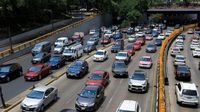As of March 31, 2025, residents of the State of Mexico have the opportunity to take advantage of a 100 percent subsidy on vehicle tenure payments for automobiles and motorcycles. This initiative, implemented by the Government of the State of Mexico, is designed to relieve the financial burden on taxpayers while also generating revenue for essential public services.
According to Óscar Flores Jiménez, the Secretary of Finance, this subsidy has been expanded to cover vehicles valued up to 550,000 pesos, an increase from the previous limit of 400,000 pesos. "We aim to benefit over two million mexiquenses with this subsidy," he stated. To avail themselves of this benefit, taxpayers must visit the official website tenencia.edomex.gob.mx to make payments online or generate a payment format to be taken to one of the more than 5,000 payment points available, including department stores, convenience stores, self-service shops, pharmacies, and banks.
The Secretary emphasized that the financial discipline and strategies implemented during Governor Delfina Gómez Álvarez's administration have resulted in a remarkable collection of 75,887 million pesos in self-generated income. As of now, there has been a 70 percent progress in the payment of endorsements and a 102 percent achievement in tenure payments compared to the targets set in the State Revenue Law for the first quarter of 2025.
To qualify for the 2025 vehicle tenure subsidy, residents must meet several requirements. These include being a natural person residing in the State of Mexico, owning a vehicle with a valid license plate valued at no more than 550,000 pesos for cars and 115,000 pesos for motorcycles (excluding VAT), providing proof of payment for the 2024 tenure, and paying the 2025 endorsement fee, which is set at 917 pesos for cars and 677 pesos for motorcycles.
On the same day, March 31, 2025, the "Hoy No Circula" program will also be in effect in Mexico City (CDMX) and the State of Mexico (EDOMEX). This program aims to protect the environment by reducing emissions from vehicles. Operating six days a week, the program restricts vehicle circulation in the Valley of Mexico from 5:00 AM to 10:00 PM.
Vehicles affected by the program include those with yellow stickers and license plates ending in 5 and 6, as well as those with verification holograms 1 and 2. These vehicles are prohibited from circulating on the streets and avenues within the designated areas. The program applies to all 16 boroughs of Mexico City and various municipalities in the State of Mexico, including Atizapán de Zaragoza, Coacalco, Cuautitlán, Chalco, Ecatepec, and Tlalnepantla, among others.
However, exemptions are in place for vehicles with verification holograms 0 and 00, electric and hybrid vehicles, emergency service vehicles, school transport vehicles, and those used by persons with disabilities.
Drivers who violate the Hoy No Circula regulations by operating their vehicles on restricted days face fines ranging from 20 to 30 Units of Measurement and Update (UMA), which translates to monetary penalties between 2,074.8 pesos and 3,112.2 pesos.
For residents in the State of Mexico, the deadline for verifying vehicles with pink stickers (plates ending in 7 and 8) is March 31, 2025. Meanwhile, vehicles with red stickers (plates ending in 3 and 4) must be verified by April 30, 2025. In Mexico City, the verification schedule is similarly structured, with pink sticker vehicles being verified during the February-March period and red sticker vehicles during March-April.
As the deadline approaches, both programs represent significant efforts by state authorities to manage vehicle emissions and support residents financially. The vehicle tenure subsidy not only aids in reducing costs for taxpayers but also plays a crucial role in funding social services, education, and public safety initiatives.
In summary, March 31, 2025, marks a critical deadline for vehicle owners in the State of Mexico to benefit from the 100 percent tenure payment subsidy, while also adhering to the restrictions set by the Hoy No Circula program. These initiatives reflect a broader commitment to both environmental sustainability and fiscal responsibility within the region.





